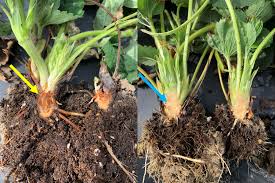Strawberry crown refers to the central part of a strawberry plant where the leaves emerge. It’s the area where the leaves meet the roots. Strawberry plants are unique in that they have a crown that is located above the soil surface, unlike most plants where the growing point is located below the soil. It is important to plant strawberries at the right depth to ensure that the crown is not buried too deeply, as this can lead to rot and other issues.
The Economic Importance and Uses of Strawberry Crown

The term “Strawberry Crown” typically refers to the central portion of a strawberry plant from which the leaves and runners emerge. It’s a critical part of the plant’s structure, containing the growing point for new leaves and flowers.
Here’s an explanation of the economic importance and uses of the strawberry Crowns:
1. Commercial Strawberry Production: Strawberry crowns are used in commercial strawberry production. Growers propagate new plants by allowing runners to root and develop into new plants. These runners are essentially stems that grow from the crown and produce new plants connected to the parent plant. This method of propagation allows farmers to efficiently expand their strawberry crops.
2. Fruit Production: The main economic benefit of the strawberry plant is, of course, the production of strawberries themselves. The crown plays a vital role in this process by producing leaves, flowers, and subsequently, fruits. Strawberries are a popular and high-value fruit consumed worldwide, and their production contributes significantly to the agricultural economy.
3. Agricultural Revenue: The cultivation of strawberries generates substantial revenue for farmers, distributors, and retailers. The demand for fresh strawberries is especially high, and they often command premium prices in the market due to their popularity, taste, and nutritional value.
4. Processed Products: Strawberries are not only consumed fresh but are also processed into various products such as jams, jellies, preserves, sauces, beverages, and frozen products. The economic impact extends to the processing industry, which adds value to the raw strawberries.
5. Export and Trade: Many countries engage in the export and import of strawberries and strawberry products, contributing to global trade. Regions with favorable climates can produce strawberries during off-seasons for other parts of the world, boosting their economy through exports.
Read Also: Strawberry Inflorescence: Economic Importance, Uses and By-Products
6. Employment Opportunities: The strawberry industry creates employment opportunities in fields such as farming, harvesting, packing, transportation, processing, distribution, and retail. This is especially important in rural areas where agricultural activities provide jobs and livelihoods.
7. Tourism and Agri-Tourism: Some regions with significant strawberry cultivation attract tourists for “pick-your-own” strawberry experiences. Tourists pay to visit farms, pick their own strawberries, and learn about the cultivation process. This diversifies revenue streams for farmers and contributes to local economies through agri-tourism.
8. Research and Development: Research on strawberry plants, including their crowns, contributes to improved varieties, disease resistance, yield enhancement, and overall agricultural efficiency. Investment in agricultural research and development benefits the industry and the economy as a whole.
9. Environmental Benefits: Strawberry plants, like other crops, contribute to soil health, biodiversity, and carbon sequestration. Sustainable strawberry farming practices can have positive environmental impacts, aligning with consumer preferences for eco-friendly products.
The Products and By-products That Can Be Derived From Strawberry Crown
The strawberry crown refers to the central growing point of a strawberry plant, which includes the stem and the base of the leaves. While the crown itself isn’t typically used to produce a wide range of products, the strawberry plant as a whole yields various products and by-products.
Here’s a list and explanation of some of them:
1. Fresh Strawberries: The most common and primary product from a strawberry plant is, of course, the fruit itself. Strawberries are consumed globally due to their sweet and juicy flavor. They can be eaten fresh, added to desserts, used in salads, or processed into various food products.
2. Frozen Strawberries: Strawberries can be frozen to preserve their freshness and nutritional content. Frozen strawberries are often used in smoothies, ice creams, and other frozen desserts.
3. Strawberry Jam and Preserves: Strawberries are commonly used to make jams, jellies, and preserves. These products involve cooking down strawberries with sugar to create spreads that can be used on bread, pastries, and more.
4. Strawberry Juice and Beverages: Strawberries can be juiced and used as a base for various beverages, including fruit juices, smoothies, cocktails, and mocktails.
Read Also: Strawberry Flowers: Economic Importance, Uses and By-Products
5. Dried Strawberries: Dehydrating strawberries removes the water content and creates dried strawberries. These can be used as snacks, in cereals, or as toppings for desserts.
6. Strawberry Flavored Products: The flavor and aroma of strawberries can be used in a wide range of products, including candies, yogurts, flavored water, and baked goods.
7. Strawberry Extracts and Flavorings: Extracts and flavorings derived from strawberries are used in the food and beverage industry to impart strawberry flavor to products without using actual fruit pieces.
8. Strawberry Cosmetics: Extracts from strawberries are sometimes used in cosmetics and skincare products due to their potential antioxidant and skin-soothing properties.
9. Strawberry Fertilizer: The decaying leaves and stems of the strawberry plant, including the crown, can be composted and used as organic fertilizer for other plants.
10. Biogas Production: In some agricultural practices, leftover plant material, including strawberry crowns, can be used for biogas production through anaerobic digestion, producing renewable energy.
11. Animal Feed: In agricultural settings, strawberry plants and their by-products can be used as feed for livestock like cattle, although this is less common due to the preference for other types of feed.
12. Research and Education: Strawberry crowns and plants are used in educational settings, research institutions, and botanical gardens for the study of plant growth, genetics, and cultivation techniques.
In conclusion, crown plays a vital role in the growth and development of the strawberry plant, which in turn contributes to the production of the aforementioned products.
Read Also: Palm Fruit: Health Benefits, Facts and Recipes
